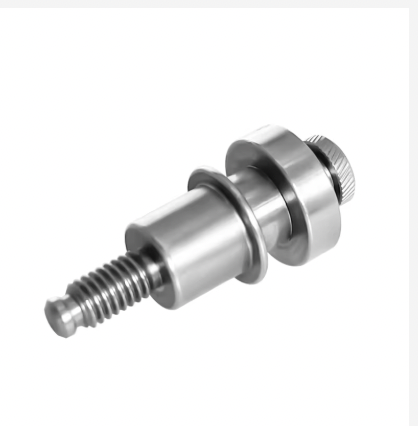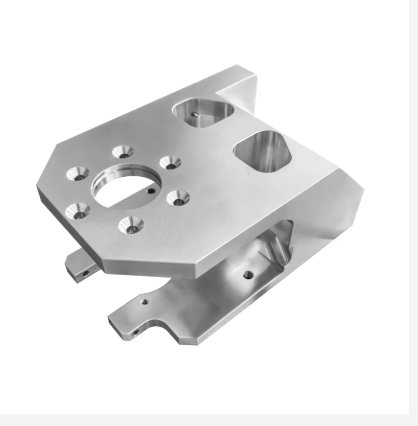Ottimizzazione della Precisione in Parti di tornio cnc
Il Ruolo Critico della Precisione nella Manifattura
L'esattezza gioca un ruolo fondamentale per la qualità del prodotto nella manifattura influenzando i requisiti di un prodotto, inclusa la funzione e le prestazioni del prodotto. Parti precise nella manifattura possono prevenire questi difetti sostituendo componenti malfunzionanti o guasti e quindi il sistema in cui vengono assemblati. Rapporti sugli Errori di Precisione nell'Industria di Macchinazione indicano che gli errori di macchinazione possono causare un aumento del 30% nei costi di produzione. Ciò accade perché gli errori possono causare ritocchi o spreco di consumabili e risorse. Inoltre, un'aumentata precisione ha anche un effetto positivo sulla soddisfazione del cliente poiché fornisce prodotti che soddisfano o superano le aspettative, portando al successo a lungo termine dell'azienda grazie all'aumento della fedeltà e alla crescita della reputazione.
Tecniche di Calibrazione Avanzate per la Coerenza
L'uso di metodi di calibrazione avanzati è fondamentale per ottenere precisione e coerenza nella lavorazione delle parti CNC. Gli strumenti di calibrazione che utilizzano il laser svolgono un ruolo importante nel ridurre gli errori della macchina e migliorare la sua precisione. La manutenzione e la calibrazione frequenti sono importanti e possono raddoppiare la durata delle macchine CNC (arrivando al 20%). Questi metodi sono stati applicati con grande successo in settori come l'aerospaziale e la produzione di dispositivi medici, portando a volumi di produzione migliori con meno errori. Per i produttori, mantenere macchine correttamente calibrate garantisce la produzione di pezzi di qualità identica, un aspetto chiave per le industrie regolate con requisiti di precisione elevata.
Raggiungere tolleranze a livello di micrometri
Il livello di tolleranza micrometrica è molto importante in settori come l'aeronautica o la sanità, dove la precisione dell'output è obbligatoria. Queste super fine tolleranze vengono raggiunte utilizzando un processo di lavorazione sub-micronico, che è una parte chiave delle capacità avanzate di CNC. Ad esempio, il rispetto dei standard regolatori rigorosi e delle misure di sicurezza è normale nel settore della produzione aeronautica. Ciò significa che la precisione non è negoziabile. E in uno studio di caso, una società di lavorazione CNC utilizzando questa forma avanzata di lavorazione ha migliorato l'integrità del prodotto, permettendo alle parti di adattarsi correttamente e funzionare. Questa precisione contribuisce alla affidabilità del prodotto e garantisce anche la compatibilità con altri elementi ad alta precisione nel prodotto finale, massimizzando così le prestazioni complessive del prodotto.
Selezione dei Materiali per Durata e Lavorabilità
La selezione del materiale è molto importante nella lavorazione di parti CNC, in quanto influisce sia sulla lavorabilità che sulla durata del prodotto. Ad esempio, proprietà come resistenza versus peso sono altamente valutate in materiali come titanio e alluminio per consentire la riduzione del peso senza perdita di resistenza nelle applicazioni. Inoltre, le classifiche di lavorabilità dei materiali vengono prese in considerazione per scegliere quelli che richiedono meno energia per il taglio e la formatura, aggiungendo così efficienza alle operazioni di fresatura CNC. Attraverso scelte informate sui materiali possiamo anche aiutare a minimizzare l'usura degli strumenti e prolungare la vita delle macchine; risultando in vite operative più lunghe e produzioni più economiche.
Ottimizzazione della geometria degli strumenti per progetti complessi
La geometria dello strumento è uno dei punti in cui possiamo fare un grande balzo in avanti nello sforzo di taglio e nella finitura della superficie in geometrie di contorno molto complesse. Diverse progettazioni geometriche degli strumenti, ad esempio angoli elicotoidali diversi o forme di fusa diverse, possono causare una grande differenza nelle prestazioni di lavorazione. Utilizziamo strumentazione dedicata per parti intricate, il che aiuta a migliorare l'accuratezza riducendo i tempi di ciclo. In particolare, nel campo aerospaziale, dove la lavorazione di parti complesse è molto comune, si conclude che una pratica migliore si ottiene progettando strumenti per ottimizzare. Esempi di applicazioni efficaci di questi progetti ottimizzati dimostrano che i miglioramenti delle prestazioni in termini di produttività e qualità sono facilmente raggiungibili progettando la geometria dello strumento per adattarla meglio alle specifiche esigenze del taglio.
Revetimenti ad alta prestazione per aumentare la durata dello strumento
I rivestimenti ad alte prestazioni sono essenziali per minimizzare l'usura degli utensili e prolungarne la durata, soprattutto in applicazioni di fresatura CNC difficili. I rivestimenti più comuni, ovvero il Nitruro di Titanio (TiN) e il Nitruro di Alluminio Titanio (TiAlN), sono noti per ridurre il attrito e migliorare la resistenza all'usura. Le ricerche indicano che un rivestimento adeguato può effettivamente triplicare la vita di un utensile. Tuttavia, naturalmente, quando si parla di rivestimenti, dobbiamo confrontare il prezzo del rivestimento con l'importo di denaro possibile da risparmiare grazie al prolungamento della vita dell'utensile. Rivestimenti di qualità significano non solo una maggiore produzione dalle nostre operazioni di fresatura, ma anche meno smaltimento e costi inferiori a lungo termine grazie al riutilizzo invece del rimpiazzo degli strumenti.
Avanzamenti nell'Automazione nella Fresatura CNC
Integrazione Robotica per la Produzione 24/7
Come i robot sono diventati un cambiamento di gioco per la lavorazione CNC. I robot si sono imposti come un fattore di cambiamento nel settore della lavorazione CNC, permettendo alle operazioni di funzionare 24/7 senza interruzioni. I robot nel processo CNC risparmiano molto sui costi del lavoro e aiutano a migliorare l'efficienza. Ad esempio, la produttività e la qualità dei prodotti sono aumentate significativamente nei settori aerospaziale e automobilistico grazie all'uso della robotica. Con l'applicazione di questi sistemi è possibile un funzionamento non assistito e un taglio preciso con un ottimo finitura negli industrie ad alta produzione. Da un lato, i robot possono alleggerire molto il lavoro, rendendo tutte le procedure di produzione omogenee e precise.
Sistemi di cambio pallet per ridurre il tempo di inattività
La tecnologia di cambio pallet sta trasformando il modo in cui i produttori utilizzano i propri macchinari CNC e sta specificamente aggiungendo valore alle tornitori consentendo loro non solo di eseguire le "impostazioni" automaticamente sui materiali convenzionali ed esotici; ma di farlo senza costi di manodopera nel processo. Tali sistemi sono molto utili all'inizio e alla fine del lavoro, contribuendo ad un maggior efficienza e produzione. Le statistiche dimostrano che le aziende che utilizzano sistemi di cambio pallet notano aumenti significativi della produttività e dei profitti. Anche se il costo iniziale di queste impostazioni può essere consistente, non ci vuole molto per recuperare questi costi grazie ai risparmi e all'aumento della produzione, risultando in un'operazione finanziariamente stabile e vincente. Con meno tempo inattivo, le aziende sono molto più efficienti nello scalare e soddisfare i propri clienti, piuttosto che aspettare che gli ordini arrivino casualmente.
Capacità di Produzione con Luci Spente
Produzione senza luce Accanto al termine viene spesso utilizzato per descrivere metodi di produzione automatizzati come quelli resi possibili da macchinari CNC avanzati e sistemi di automazione. Questo metodo offre benefici come il risparmio di manodopera e il miglioramento della produttività in un settore così competitivo. Esempi reali (ad esempio, dall'industria aerospaziale) dimostrano il successo delle funzioni senza luce nella produzione di massa. Tuttavia, l'integrazione di tali sistemi presenta sfide, tra cui la manutenzione degli equipaggiamenti e il monitoraggio dei processi. Un piano strategico efficace dei processi di automazione e l'utilizzo di tecnologie consolidate possono eliminare questi ostacoli e garantire una struttura di produzione altamente efficiente e automatizzata.
Integrazione del software per migliorare le prestazioni CNC
Sincronizzazione CAD/CAM per ridurre gli errori
La collaborazione tra CAD e CAM è fondamentale per ridurre gli errori manuali e semplificare la produzione CNC. Questa sincronizzazione consente di ottenere una vera rappresentazione del progetto con una probabilità minore di errori di produzione. Si riferisce che l'industria abbia registrato una riduzione di un ordine di grandezza degli errori grazie all'uso dei sistemi CAD/CAM. Ad esempio, aziende come Siemens e Autodesk, integrando CAD/CAM, sono state in grado di realizzare impressionanti progressi sia in termini di precisione che di efficienza operativa. Effetto positivo per le imprese - La connessione CAD/CAM Di: Paul Gherasim Questo articolo cerca di analizzare l'influenza delle associazioni CAD/CAM sulle operazioni dell'impresa. Dotati di questi strumenti, i produttori possono migliorare la precisione e ridurre costosi errori.
Simulazione alimentata dall'Intelligenza Artificiale per la validazione del processo
Le simulazioni AI consentono un modello predittivo che permette la rilevazione precoce dei problemi di produzione e, di conseguenza, processi più fluidi. 'Usa l'IA per modellare i processi: l'IA può prevedere e affrontare sfide per mantenere il flusso di produzione senza interruzioni. Grandi aziende, tra cui GE e Dassault Systemes, hanno utilizzato simulazioni supportate dall'IA per rinforzare le linee di produzione, migliorare la qualità dell'output e le efficienze. L'agilità e la previsione fornite dall'IA sono un aspetto importante per ridurre i costi imprevisti di produzione in linea con il piano d'azienda. Queste simulazioni sono necessarie per verificare i processi e offrire un'esperienza di produzione fluida.
Algoritmi di Ottimizzazione del Toolpath
Gli algoritmi di ottimizzazione del percorso degli strumenti sono molto efficaci nel minimizzare il tempo di produzione e nel migliorare l'accuratezza della lavorazione nella fresatura CNC. L'ottimizzazione del percorso degli strumenti rende questi algoritmi più efficienti e garantisce una qualità del prodotto superiore. I software forniti dai produttori come Mastercam e Mach3 dimostrano un'ottimizzazione avanzata del percorso degli strumenti e i guadagni di produttività possono essere significativi. Si è registrato un aumento dimostrabile del tempo di esecuzione fino al 20% e del potere trasformativo sui tempi di ciclo. Essi consentono di rendere la produzione sia efficiente che di qualità, raggiungendo costanza e una perfetta ripetibilità delle operazioni di lavorazione anche nel caso di lavorazioni complesse.
Integrando queste funzionalità avanzate del software, le aziende possono garantire di rimanere all'avanguardia delle prestazioni CNC, ottimizzando i propri processi e riducendo notevolmente le inefficienze.

Monitoraggio Continuo e Ottimizzazione dei Processi
Monitoraggio della Salute delle Macchine Abilitato da IoT
Avere le macchine CNC collegate all'Internet delle Cose (IoT) ha segnato un cambiamento significativo in modo in cui queste macchine possono essere monitorate in tempo reale. Il monitoraggio della salute delle macchine attraverso l'IoT permette di monitorare le prestazioni delle macchine in funzione in tempo reale, identificando i problemi prima che si verifichino, minimizzando così il tempo di inattività. Poiché le soluzioni IoT raccolgono e analizzano continuamente i dati, possono riconoscere schemi che indicano usura, rendendo possibile la manutenzione predittiva. Di conseguenza, non solo preclude interruzioni impreviste, ma migliora anche l'efficienza dell'operazione del sistema in modo efficace. Piccole, medie e anche grandi aziende stanno ottenendo ottimi risultati implementando soluzioni IoT per le macchine CNC. Ad esempio, un importante produttore afferma di aver aumentato il tempo di attività delle macchine del 20% utilizzando l'IoT per monitorare la salute delle macchine e prevedere quando avranno bisogno di manutenzione.
Controllo Adaptativo per Regolazioni Dinamiche
Per adattarsi ai cambiamenti del processo produttivo, il sistema di controllo adattivo nella tagliatura CNC è molto importante. Essi ottimizzano automaticamente le impostazioni di lavorazione, inclusa la velocità di taglio, il tasso di avanzamento e l'ingresso dello strumento in base alle condizioni di taglio, garantendo la stessa eccellente qualità e precisione. In questo modo, il controllo adattivo riduce la quantità di pezzi difettosi e aumenta l'efficienza della produzione. Studi mostrano che utilizzando il controllo adattivo, l'efficienza di lavorazione può aumentare del 30% o più. Alcuni casi di implementazione riuscita dimostrano come i sistemi adattivi siano stati fondamentali per migliorare le linee di produzione. Prendiamo l'esempio della produzione automobilistica, dove i sistemi di controllo adattivo mantengono una tolleranza molto bassa per quanto riguarda la qualità e minimizzano lo spreco di materiale.
Strategie di Riduzione dei Rifiuti Guidate dai Dati
Costoro fungono da punto di partenza per qualsiasi analisi che possa essere utilizzata per eliminare sprechi ed inefficienze nel processo di lavorazione CNC. Utilizzando un approccio basato sui dati, un'azienda conosce esattamente dove nella catena di approvvigionamento vengono utilizzati eccessivamente i materiali o dove l'energia viene utilizzata in modo inefficiente, in modo da poter adattare direttamente i propri processi e ridurre gli sprechi - e i costi - in modo visibile. Questa riduzione degli sprechi avrà benefici finanziari significativi in termini di riduzione dei costi di produzione e aumento dei margini di profitto. I gruppi di produzione sostenibile hanno ottenuto alcuni successi significativi nella lotta contro lo spreco. Per esempio, una delle principali aziende di lavorazione CNC ha ridotto lo spreco di materiali del 25% studiando i dati di produzione, e ciò ha portato a riduzioni di costo importanti e ha anche soddisfatto il loro obiettivo strategico di ridurre lo spreco. Quindi è molto più di un piano per l'ambiente; l'analisi dei dati rende ogni aspetto delle operazioni CNC più efficiente.
Sezione FAQ
Qual è l'importanza della precisione nella lavorazione CNC?
La precisione è fondamentale nella lavorazione CNC poiché garantisce la funzionalità e le prestazioni del prodotto finale, riduce gli errori e lo spreco di materiali e migliora la soddisfazione del cliente.
Come contribuiscono le tecniche di calibrazione avanzate alla lavorazione CNC?
Le tecniche di calibrazione avanzate aiutano a mantenere l'accuratezza della macchina, ridurre i tassi di errore e garantire un miglioramento degli output produttivi, che sono essenziali per le industrie ad alta precisione.
Perché i rivestimenti ad alte prestazioni sono essenziali per gli attrezzi CNC?
I rivestimenti ad alte prestazioni riducono l'usura degli attrezzi, ne prolungano la durata e migliorano l'efficienza della lavorazione, il che, a sua volta, aumenta la produttività e la sostenibilità.
Qual è il ruolo dell'automazione nei miglioramenti della lavorazione CNC?
L'automazione consente una produzione 24/7, riduce i costi del lavoro e migliora la coerenza e la precisione, ottimizzando in modo significativo i processi di produzione.
In che modo la tecnologia IoT migliora la lavorazione CNC?
La tecnologia IoT migliora il monitoraggio in tempo reale delle macchine, consentendo la manutenzione predittiva che riduce i tempi di inattività e migliora l'efficienza operativa.
Le strategie basate sui dati possono portare alla riduzione dei rifiuti nelle operazioni CNC?
Sì, le strategie basate sui dati identificano inefficienze, ottimizzano i processi e riducono i rifiuti, portando a risparmi di costi e migliorando la sostenibilità.
Indice
- Ottimizzazione della Precisione in Parti di tornio cnc
- Selezione dei Materiali per Durata e Lavorabilità
- Ottimizzazione della geometria degli strumenti per progetti complessi
- Revetimenti ad alta prestazione per aumentare la durata dello strumento
- Avanzamenti nell'Automazione nella Fresatura CNC
- Integrazione del software per migliorare le prestazioni CNC
- Monitoraggio Continuo e Ottimizzazione dei Processi
-
Sezione FAQ
- Qual è l'importanza della precisione nella lavorazione CNC?
- Come contribuiscono le tecniche di calibrazione avanzate alla lavorazione CNC?
- Perché i rivestimenti ad alte prestazioni sono essenziali per gli attrezzi CNC?
- Qual è il ruolo dell'automazione nei miglioramenti della lavorazione CNC?
- In che modo la tecnologia IoT migliora la lavorazione CNC?
- Le strategie basate sui dati possono portare alla riduzione dei rifiuti nelle operazioni CNC?

